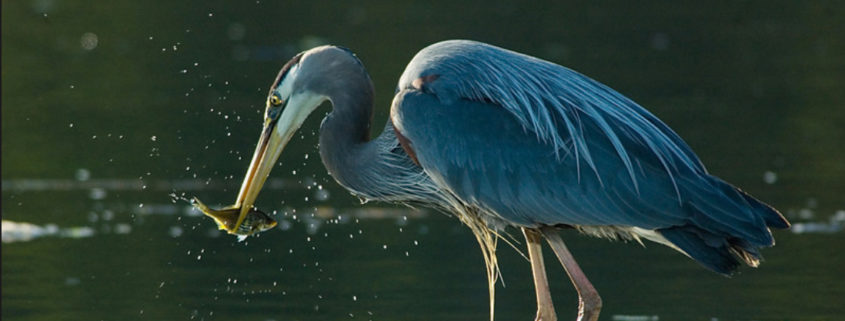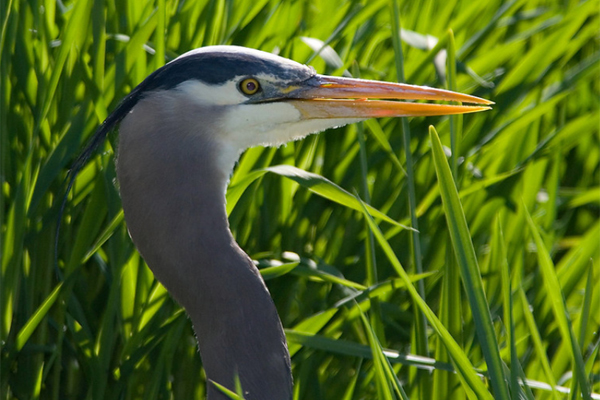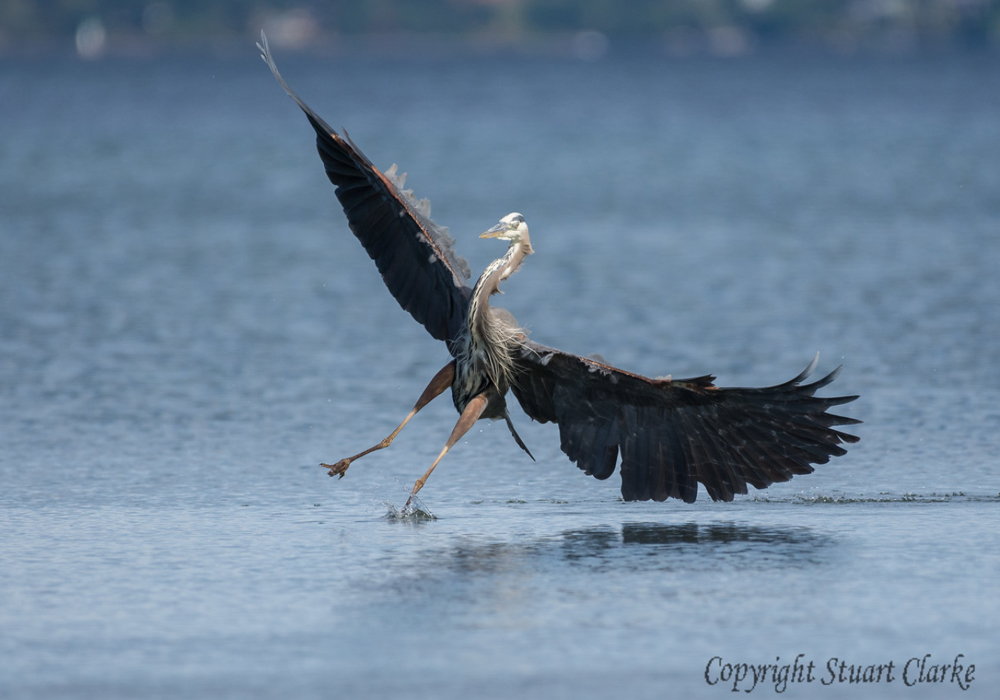Great Blue Heron
Author: Thomas Woodruff
Photos by Stuart Clarke
Scientific name: Ardea herodias
Size range: 1m to 1.3m in height with a wingspan up to 2m
Identifying features: The bodies of Great Blue Herons are blue-gray in colour while their heads are white with a black streak above the eyes which have blue rings around them. They have long, pointed, yellowish beaks. They also have long legs which allow them to easily wade in water which is where they hunt for a majority of their prey. Besides wading in water they can be found in the sky and nesting in trees. Another identifying feature of Great Blue Herons is their long neck which is usually curled in an “s” shape.
Habitat: The Great Blue Heron is prominent throughout North America as well as Mexico, the Caribbean and South America for migration. While some of them migrate they are able to survive during the winter in cold locations as long as fish-bearing waters remain unfrozen. Great Blue Herons can adapt to almost any wetland habitat. They can be found in fresh and saltwater marshes, mangrove swamps, flooded meadows, lake edges and shorelines.
Prey: Great Blue Herons primarily eat small fish but will opportunistically eat shrimp, crab, aquatic insects, rodents, other small mammals, amphibian, reptiles and birds, especially ducklings. Primary prey is based on availability and abundance. In British Columbia the primary prey species are sticklebacks, gunnels, sculpins and perch. Herons use sight to locate their prey and will swallow it whole. They are solitary feeders and will hunt in shallow water or fields; wading with their long legs they will quickly stab prey with their sharp beak.
Predators: The main threat to Great Blue Heron eggs are Turkey Vultures, Common Ravens, American Crows and raccoons. Red-tailed Hawks, American Black Bears and raccoons will try to take larger nestings and fledgelings. Adults have few predators which include Bald Eagles, Golden Eagles and, less frequently, Great Horned Owls and Harris’s Hawk. A fully grown Great Blue Heron is a formidable foe with its large size and dagger-like bill. When predators attack a breeding colony, the colony will sometimes be abandoned by the birds. Humans are the primary source of disturbances and breeding failures at colonies because of human recreation or habitat destruction as well as hunters and egg collectors.
Life cycle: Great Blue Herons reproduce sexually. They will create a nest with sticks high up in a tree, on the edge of a cliff or in reeds. They will usually nest in colonies. A female will typically lay two to seven eggs over the course of five days. The female will then sit on them for incubation until they hatch in about 25-30 days. The chicks will develop feathers for flight after two months.
References:
Peterson, R. (1990). Western birds. Boston, New York
Fitzpatrick, J. (2002). Field guide to the birds of North America. Washington, D.C.
PBS. (2018). Great blue heron. NatureWorks. Retrieved November 20, 2018 from https://nhpbs.org/natureworks/greatblueheron.htm
Cornell lab of ornithology. (2017). Great blue heron. Allaboutbirds. Retrieved November 26, 2018 from https://www.allaboutbirds.org/guide/Great_Blue_Heron/
Thanks to Stuart Clarke for the photos
Photo links:
https://www.raincoastphoto.com/Birds-of-British-Columbia/Wading-Birds1/Great-Blue-Heron/i-CqLXFKs/A
https://www.raincoastphoto.com/Birds-of-British-Columbia/Wading-Birds1/Great-Blue-Heron/i-PNrQZHJ/A
https://www.raincoastphoto.com/Birds-of-British-Columbia/Wading-Birds1/Great-Blue-Heron/i-3vj3RVT/A
https://www.raincoastphoto.com/Birds-of-British-Columbia/Wading-Birds1/Great-Blue-Heron/i-N2pb2bS/A







Leave a Reply
Want to join the discussion?Feel free to contribute!